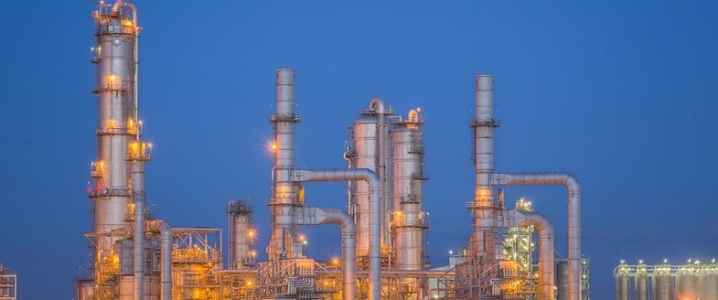Saudi Arabia may have started to fill up its oil tanks, export and domestic consumption data suggests, as cited by Bloomberg’s Julian Lee. Traditionally, the summer months are the season of peak local consumption of crude, Lee notes, as air conditioning demand hits a high. However, this year temperatures have been below the five-year average for the period, and exports have not registered any marked increases, either.
Saudi Arabia has abundant storage capacity and over the last three years, stockpiles have been falling, from more than 300 million barrels to less than 250 million barrels, according to data from JODI quoted by Lee. At the end of April this year, they stood at the lowest level since 2011, but in May they went up for the first time since last November. They may well have continued to rise in the following months as well.
At the same time, Reuters cited two unnamed sources from OPEC as saying Saudi crude oil production in July fell by 200,000 bpd instead of rising, as per the OPEC+ agreement from June 22. This is a surprising turn of events after Saudi Arabia assured importers that India and the United States it would ramp up production quickly and solidly. Related: OPEC Oil Production Surges 340,000 Bpd As Saudis Pump Near Record
The decline is all the more surprising after Saudi reports to OPEC that the Kingdom boosted production in June by as much as 500,000 bpd, to 10.488 million bpd. Secondary sources data for June actually showed Saudi Arabia had produced an average of 10.42 million bpd, which was 405,400 bpd more than in May—still a substantial increase.
Saudi Arabia has storage capacity in excess of 40 million barrels of crude, both at home and abroad. Its biggest storage terminal is Ras Tanura, with 33 million barrels. Another major storage hub is the King Fahd terminal, with a capacity of 12.5 million barrels of crude. If Saudi Arabia has started replenishing these, it will gain a certain edge over competitors after the Iran sanctions begin to take their toll on international prices.
By Irina Slav for Oilprice.com
More Top Reads From Oilprice.com:
- Locked Into Hedges, Shale Misses Out On Oil Price Rally
- The Key Oil Price Driver By 2020
- Diesel Trucks Aren’t Going Anywhere



















you wrote:
"Saudi Arabia has abundant storage capacity and over the last three years, stockpiles have been falling, from more than 300 million barrels to less than 250 million barrels, according to data from JODI quoted by Lee"
and then you wrote:
"Saudi Arabia has storage capacity in excess of 40 million barrels of crude, both at home and abroad. Its biggest storage terminal is Ras Tanura, with 33 million barrels. Another major storage hub is the King Fahd terminal, with a capacity of 12.5 million barrels of crude."
What is the right figure for Saudis´ oil storage capacity?
Thanks
Fernando
The first is that Saudi Arabia is taking very seriously Iran’s threat to disrupt oil shipments through the Strait of Hormuz if it was prevented from exporting its own oil as a result of US sanctions.
Saudi Arabia has the 750-mile Petroline (or East-West Pipeline) which runs across Saudi Arabia from the East to the Red Sea in the West at the Yanbu port. Through the Petroline with a capacity of 4.8 mbd, some Saudi oil could bypass both the Straits of Hormuz and Bab al-Mandeb, linking up with tankers at Yanbu port and from there towards the Suez Canal and the Mediterranean.
The other explanation is that Saudis have not been truthful about their proven oil reserves, production capacity and spare production capacity. They claim they could produce 12.5 mbd if it is really needed. However, this claim doesn’t stand scrutiny. Saudi oil production peaked in 2005 at 9.64 mbd and has been in decline since. Out of 10.4 mbd they said they were producing, almost 1 mbd was not actual production but withdrawal from their oil stocks stored on board tankers and on land. Even the 400,000 b/d they claim to have added recently came from their stored oil and were not actual production. Their claim that they have a spare capacity of 2 mbd is also not true. That is why their oil stocks have been steadily declining.
Saudi Arabia’s suspension of oil shipments through the Strait of Bab al-Mandeb after the attack on its oil tankers in the Strait by the Houthi rebels in Yemen has demonstrated the vulnerability of the world’s major oil chokepoints, namely, the Straits of Hormuz, Bab al-Mandeb, Malacca and the Suez Canal, to disruption.
Iran has threatened to close the Strait of Hormuz if it was prevented from exporting its crude oil as a result of US sanctions. Iran’s threat should be taken seriously.
The Strait at its narrowest point is 21 mile wide so it is impossible militarily to close it completely. But Iran can mine stealthily with the expectation of a mine hitting an oil tanker and sinking it. Such an accident in itself would deter tankers from crossing the Strait thus causing a disruption in oil supplies until the mines are cleared.
Alternatively, Iran could threaten sinking tankers crossing the Strait even if escorted by the US Fifth Navy in the Gulf. This threat might deter tanker owners around the world from sending their tankers across the Strait under pressure from global insurance companies until tension has subsided. In this way, Iran would have achieved its goal of disrupting oil supplies peacefully.
Dr Mamdouh G Salameh
International Oil Economist
Visiting Professor of Energy Economics at ESCP Europe Business School, London
is much more noticeable!